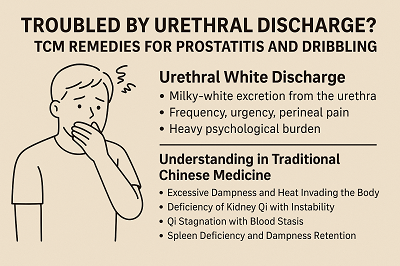Troubled by Urethral Discharge? TCM Remedies for Prostatitis and Dribbling
Urethral white discharge, a classic and embarrassing symptom of prostatitis, manifests as milky-white excretion from the urethral meatus following urination or defecation. It is typically accompanied by urinary discomforts, including frequency, urgency, and perineal distending pain. This condition inflicts not merely physical suffering but also a heavy psychological burden—many patients experience heightened anxiety due to concerns about misdiagnosis as sexually transmitted infections (STIs), which may further impair social interactions and sexual function.

Pathological association Between Prostatitis and Urethral White Discharge

Prostatitis is a common condition affecting the male urinary and reproductive systems. Clinically, it is mainly divided into two types: bacterial prostatitis and non-bacterial prostatitis. Bacterial prostatitis is primarily caused by infections with urinary tract pathogens, presenting with sudden symptoms of urinary tract irritation and systemic signs of infection. Non-bacterial prostatitis, on the other hand, has more complex causes related to pelvic floor muscle tension, urine reflux, and immune factors, among others.
The phenomenon of urethral discharge of mucus mainly occurs in patients with non-bacterial prostatitis. The physiological mechanism mainly involves:
Abnormal excretion of prostatic fluid: The prostate, as the largest accessory gland in men, will increase its excretion when the gland is stimulated by inflammation. After urination or defecation, mucus excretions may appear at the urethral opening, thereby causing pathological turbid fluid.
Dysfunction of the urethral sphincter: Urethritis can lead to an increase in urethral excretions and also cause pathological urethral discharge.
Other diseases: Prostatitis, benign prostatic hyperplasia, urinary system stones and other conditions may also cause discharge from the urethral opening.
This urinary dribbling is similar to the normal prostatic fluid composition, but contains more inflammatory cells and epithelial debris, and has a more turbid appearance. Unlike pathological ejaculation, urethral whitening often occurs at the end of urination or during forceful defecation, without the sensation of ejaculation. The amount discharged is small and cloudy, and it does not liquefy.
The Understanding and Diagnostic System of Traditional Chinese Medicine Regarding Prostatitis
In the theoretical system of traditional Chinese medicine, prostatitis falls under the categories of "jing zhuo" (seminal fluid cloudy.), "bai zhuo" (urinary tract turbidity), and "lin zhen" (urinary tract disorder). This medical insight originates in the Huangdi Neijing. By the Sui Dynasty, Chao Yuanfang's Treatise on Causes and Manifestations of Diseases had already provided a dedicated exposition on "urinary white turbidity." Traditional Chinese Medicine attributes the etiopathogenesis of prostatitis-related urethral discharge to four aspects:
1. Excessive Dampness and Heat Invading the Body
An uncontrolled diet leads to the generation of dampness and heat in the spleen and stomach, or external dampness invades the body and penetrates along the meridians, accumulating in the seminal vesicle and urethra, blocking the qi flow and disrupting the normal descent. The dampness and heat vaporize, causing the essence to deteriorate and become turbid, resulting in urethral discharge of white substances. Such patients often present with symptoms such as short, red urine, dampness in the scrotum, a bitter and greasy mouth, a red tongue with a yellow and greasy coating, etc., which are typical signs of dampness and heat.
2. Deficiency of Kidney Qi with Instability
Excessive fatigue, improper sexual activity, or prolonged illness damaging the kidneys leads to deficiency of kidney qi, weakened ability to store and secure essence, and continuous leakage of semen. Kidney deficiency can be classified into two types: yin deficiency and yang deficiency.
- Kidney Yin Deficiency: Weakness in the lower back and knees, hot sensations in the palms, soles, and chest, and red tongue with little coating.
- Kidney Yang Deficiency: Feeling cold, cold limbs, decreased sexual desire, pale and swollen tongue
3. Qi Stagnation with Blood Stasis
Unresolved emotions lead to the obstruction of liver qi, and the circulation of blood and qi is blocked; or due to prolonged illness, blood, and qi become stagnant in the lower jiao, forming the syndrome of "qi and blood stasis." Most patients present with persistent stabbing pain in the perineal area and the area above the pubic bone, darkened eye sockets, purplish spots on the tongue, and hard nodules or tenderness upon prostate palpation.
4. Spleen Deficiency and Dampness Retention
Excessive diet and fatigue can damage the spleen and stomach, resulting in insufficient middle qi, poor transportation of water and dampness, and downward leakage of essence. Such patients, in addition to urinary dribbling, often present with symptoms of fatigue and weakness, a feeling of fullness in the lower abdomen, and post-urination dribbling. These are manifestations of the sinking of the spleen qi.
Differential Treatment: Detailed Explanation of Oral Traditional Chinese Medicine Regimens
In traditional Chinese medicine treatment, the principle of "observing the pulse and symptoms, identifying the type of error committed, and treating accordingly" is emphasized. Different prescriptions are used based on different syndromes:
1. Damp-Heat Accumulation Syndrome
Commonly used traditional Chinese medicine is the "Diuretic and Anti-inflammatory Pill", whose main ingredients include Plantago asiatica, Talcum, dianthus superbus, Polygonum aviculare, safflower, Peach Kernel, Angelica Sinensis, Red Peony Root, Houttuynia cordata, Semen Vaccariae, etc. The treatment method primarily focuses on clearing heat and detoxification, promoting blood circulation and resolving stasis, as well as alleviating pain.
2. Kidney Yin Deficiency Syndrome
Commonly used traditional Chinese medicines include Rehmanniae Radix Cruda, Rehmanniae Radix Praeparata, Dioscoreae Rhizoma, Anemarrhenae Rhizoma, Moutan Cortex, Salviae Miltiorrhizae Radix, Alismatis Rhizoma, Poria, Paeoniae Radix Rubra, Phellodendri Cortex, and Achyranthis Bidentatae Radix, among others. The treatment methods primarily focus on nourishing the liver and kidneys, promoting blood circulation, and eliminating dampness.
3. Kidney Yang Deficiency Syndrome
The commonly used drugs include Chinese plum, Poria cocos, cinnamon, aconite, walnuts with skins (lightly roasted), Chinese yam, safflower, Schisandra chinensis, Schisandra berries, Rehmannia glutinosa, celestite, Hei Xi Dan. The treatment principle is mainly to warm the yang, nourish the kidney, strengthen the spleen, and transform dampness.
4. Stagnant Qi and Blood Stasis Syndrome
Commonly used drugs include Red Peony Root, Processed Myrrh, Red Flower, Herba Lycopi, Semen Vaccariae, Green Peel, Pangolin, Prepared Olibanum, Corydalis Rhizoma, Hedyotis Herb, Toosendan Fructus, Angelicae Dahuricae Radix, Taraxaci Herba, Patriniae Herba, Leonuri Herba, Persicae Semen, Polygoni Cuspidati Rhizoma, Salviae Miltiorrhizae Radix, and Glycyrrhizae Radix et Rhizoma. The treatment principle primarily focuses on soothing the liver, promoting blood circulation, and removing blood stasis.
Overall treatment: the Core Advantage of Traditional Chinese Medicine Therapy
Compared with the standardized treatment methods of Western medicine, which mainly involve the use of antibiotics (such as levofloxacin), α-receptor blockers (tamsulosin), and non-steroidal anti-inflammatory drugs, the treatment of prostatitis with urethral discharge by traditional Chinese medicine demonstrates unique advantages:
1. Individualized Treatment under the Guidance of an Overall Concept
In traditional Chinese medicine, the overall syndrome differentiation is the core principle. Treatment plans are formulated based on the specific syndrome type, physical constitution characteristics, and stage of disease progression in the patient.
2. Comprehensive Effect of Addressing Both the Symptoms and the Root Causes
Traditional Chinese medicine not only aims to eliminate urethral discharge but also focuses on overall conditioning. While clearing heat and promoting diuresis, it also strengthens the spleen and consolidates the foundation. While promoting blood circulation and resolving stasis, it also nourishes the kidneys and enhances sperm production. This significantly reduces the recurrence rate.
3. Advantages in Safety and Tolerance
The side effects of traditional Chinese medicine are significantly fewer than those of long-term use of antibiotics and alpha receptor blockers. Apart from a few patients experiencing mild gastrointestinal discomfort, no serious adverse reactions have been reported in the treatment with traditional Chinese medicine. It is particularly suitable for long-term conditioning.
In treating prostatitis with urinary dribbling from a Chinese medicine perspective, we adopt an overall approach based on syndrome differentiation and treatment. Through various methods, including internal medication and external treatment with traditional Chinese medicine, it not only effectively reduces or eliminates the symptoms of urinary dribbling from the urethra but also enhances overall function, improves the quality of life, and reduces the risk of recurrence.



